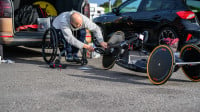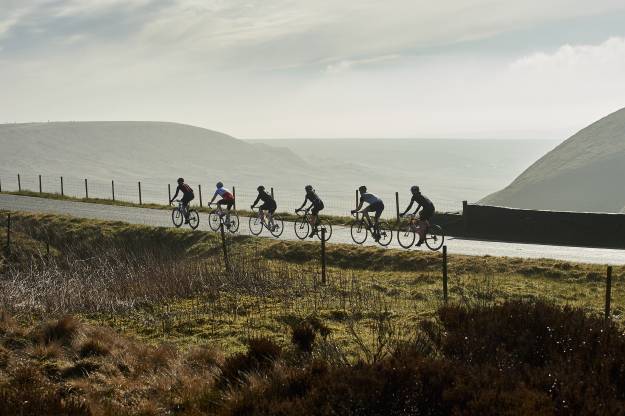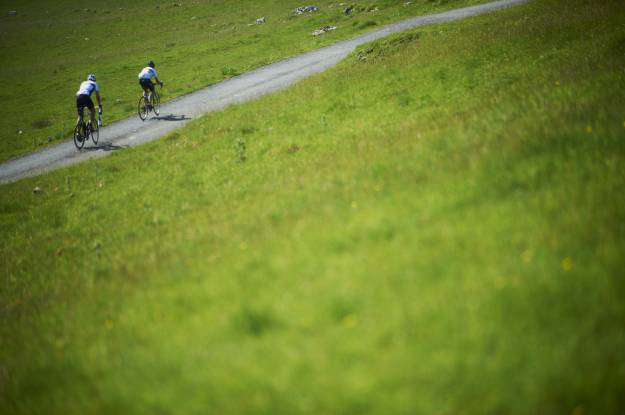Weekly introductions to the eight-week Sofa to 50km training plan.
Download the Sofa to 50km Plan here
Week 1
The main focus of this week is digging your bike out of the shed, making sure it is safe and ready to ride and then getting out for three short rides.
Is your bike well maintained and ready to ride on the road? Book it into your local bike shop for a service and, if it is a mountain bike with knobbly tyres, consider asking them to fit some energy saving, road friendly slick tyres.
Is your bike correctly set-up and fitted to you?
Padded cycling shorts are a must have and will make a massive difference to your comfort on the bike. If you are not comfortable with the lycra look, you can always wear baggy shorts over the top.
Stay well hydrated, aim to drink at least 1.5 litres of water a day.
Cycling is more fun in a group. See if you can persuade some friends to join you in working through the training plan.
Week 2
Now your bike is set-up correctly and you have been out on it a few times, we can start increasing the duration of your rides.
Check your tyres before each ride, they should feel firm and only give slightly when you press with your thumb. At the end of each ride, check them over again for any flints or shards of glass that might have worked their way into the rubber.
As you are out for an hour by the end of this week, you should be aiming to drink 500-750 ml of water on your ride. Practice removing and replacing a water bottle from its cage. Do this and take a sip of water every 10-15 minutes on all your rides from now on.
Try to avoid eating a full meal in the two hours before a ride. If you are hungry, a banana an hour or so before you head out is ideal.
Week 3
On your midweek rides this week, push your pace a little bit for the middle 20 minutes. This doesn’t mean riding all-out, just lifting the intensity a little. You should still be able to talk but in shorter sentences. For the longer weekend ride, keep the pace constant and easy.
Are you confident fixing a flat and do you know what spares and kit you should carry when out riding?
You need to start thinking about eating on the bike to fuel your longer rides. Little, often and early should be your motto. From the start of the ride, aim to eat something every 20-30 minutes. It doesn’t have to be a gel, breakfast bars, fig rolls, jam sandwiches or dried fruit are all good. Check out our recipes for snacks you could make to take on the bike. Experiment with what works for you and don’t leave eating until you feel hungry. When riding, you are not eating for that moment but 5-10 kilometres down the road.
Week 4
At the halfway point in the plan, you will be riding for up to 2-hours this weekend. Think about planning a café stop around the halfway point of your route but don’t neglect to eat and drink while on the bike also. Remember the advice from last week and the “little, often and early” motto.
How was your backside feeling on the bike? There is some great advice on reducing saddle soreness from Great Britain Cycling Team lead physiotherapist, Phil Burt.
How did you feel after your 2-hour ride? If you got your nutrition right, you should have felt hungry but not famished. It is important to eat as soon as you get back from your weekend rides to kick start your body’s recovery. You need some protein and carbohydrates so, something like a tuna or chicken sandwich is ideal. If you don’t feel like eating, a banana blended in 500 ml of whole milk is also perfect.
Week 5
With four solid weeks of riding in your legs, this week is about resting and recovering. It is only by doing this that your body will adapt to the training you have done and become stronger. There are a number of steps you can take to maximise your recovery.
Apply a recovery mindset to your cross-training sessions this week too. They should be non-impact and restorative. You could even do some focused mobility work or even treat yourself to a massage.
With the extra time you have got this week with less riding to do, give your bike a good clean and, if there have been any problems with it, maybe book it in for a service.
Are you doing an organised event for your 50 km ride? If you haven’t already entered, you might be able to find a suitable one on the British Cycling Events Calendar.
Week 6
With your longest weekend ride of the plan, really concentrate on getting your pacing and nutrition right. If you are riding with friends, on flat straight sections, take turns riding on the front and, when it is not your turn, shelter behind out of the wind. You will be amazed how much easier it is. If you are aiming to complete an organised event, learning to ride in a group is really useful.
One of your midweek rides requires you to seek out a hill. It doesn’t have to be super steep or long but should have you out of breath by the top and take 3-5 minutes to ride. On the ups, experiment with climbing seated and standing. In general, using a low gear and staying seated is more efficient but sometimes a steep hill will force you to stand up. Practice your descending technique as you recover on the way down.
Week 7
Don’t worry if you feel quite tired this week, you did a lot of riding the week before. You are now starting to taper down. By gradually reducing the amount of riding you are doing over the next two weeks, your body will recover, become stronger and you will be in the best condition possible on the day of your 50 km ride. Have confidence in the training you have done and don’t be tempted to try to do last minute extra rides.
Make a checklist of all the kit and food you will need next weekend and double check the event start times, how long you will need to leave to get there and that your travel plans are all in place. Do everything you can now to avoid unnecessary stress on the morning of your ride.
Even though your weekend ride is shorter than the previous three weeks, it is really important that you don’t neglect your pre, during and post ride nutrition. Your body needs the food to recover and become stronger so ensure you stick to the same routines as on the longer rides.
Week 8
If you have followed the plan, you will be feeling fit and ready to go. With fairly short midweek rides, you may even feel a little too keen. Don’t be tempted to try and do some last minute crammer training, you will only add fatigue rather than fitness to your legs. The short rides, as opposed to complete rest, will keep you ticking over and prevent your legs feeling heavy.
Lay out all of your food and kit on the Friday, this will give you a day if you are missing anything. Check the weather forecast and make sure you have the appropriate kit and clothing.
Follow your tried and tested pre-ride routine, don’t be tempted to do anything different and give yourself plenty of time to get to your event.
Stick to the same pacing, eating and drinking as on your training rides and, most importantly, enjoy the company, the cycling and be proud of what you have achieved.
What next?
By following the 8-week Sofa to 50 km Training Plan you will have become fitter, healthier and hopefully will have discovered a love for cycling. You are now in an ideal position to progress on to our Century plan and target a 100 km ride.
With a 50 km under your belt, there is no need to start at Week 1, you can enter the plan at Week 5. The main difference from the Sofa to 50 km Plan is that, rather than RPE, intensity is monitored using heart rate. When starting at week 5, replace the Tuesday session with a Threshold Test as this will allow you to set your heart rate training zones.
Heart rate monitors have become very affordable and allow accurate and objective measurement of intensity. Using one will help to ensure that you are always riding at the correct intensity and getting the most from the training you do.











